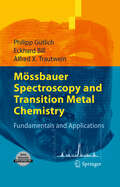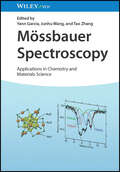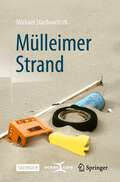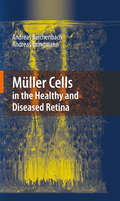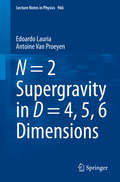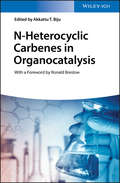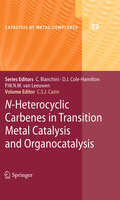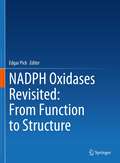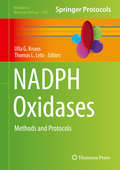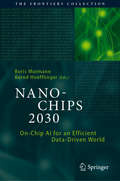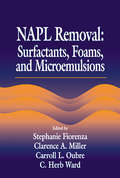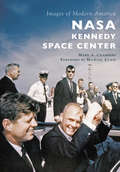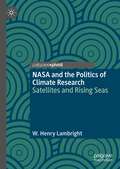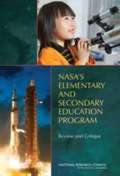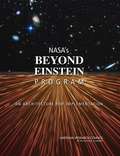- Table View
- List View
Más allá de las estrellas: ¿Estamos solos en el universo?
by Álex Riveiro¿Hay vida en otros lugares del Sistema Solar? ¿Cuántas civilizaciones pueden existir en la galaxia? ¿Nos conoceremos algún día? Desde pequeños, nos fascinan las estrellas y los planetas. En seguida nos preguntamos si en su superficie podría haber criaturas, como tú y como yo, preguntándose si en otros lugares de la galaxia habrá seres como ellos... La avalancha de preguntas es imparable: el ser humano es curioso por naturaleza. Si alguna vez te has hecho alguna de estas preguntas, este libro es para ti. De la mano de Alex Riveiro, autor de Hacia las estrellas. Una breve guía del universo, y creador de Astrobitácora, el podcast de referencia de astronomía en español.
Más allá del Big Bang: Un breve recorrido por la historia del universo
by Iván AgullóUna provocación al intelecto que nos embarca en un viaje fascinante a través del tejido cósmico. ¿Qué fue el Big Bang realmente? ¿El universo es eterno o tuvo un comienzo? ¿Tendrá un final? El lector tiene entre manos una obra que pone las grandes cuestiones del universo al alcance de todos. Con la capacidad de presentar con sencillez temas tan sumamente complejos como la Teoría de Cuerdas y la Gravedad Cuántica de Lazos, Iván Agulló aporta algo de orden al caos infinito de interrogantes que la cosmología enfrenta en la actualidad. Lo hace mediante esta breve historia del universo y de los brillantes teóricos que han revolucionado por completo los cimientos de la ciencia y de nuestro entendimiento de todo cuanto nos rodea. Con una gran profundidad intelectual y filosófica, este libro logrará expandir el universo de ideas que cualquier mente curiosa alberga.
Möglichkeiten der Kanalzustandsprognose: Grundlage der betrieblichen Anlagenoptimierung – ein Methodenvergleich
by Andrzej RaganowiczDieses Buch bietet eine detaillierte Darstellung der Vorgehensweise der Erstellung von Kanalzustandsprognosen sowie eine praxisorientierte Anleitung für die Interpretation der Ergebnisse.
Mössbauer Spectroscopy
by Guido Langouche Yutaka YoshidaTutorials on Mössbauer Spectroscopy Since the discovery of the Mössbauer Effect many excellent books have been published for researchers and for doctoral and master level students. However, there appears to be no textbook available for final year bachelor students, nor for people working in industry who have received only basic courses in classical mechanics, electromagnetism, quantum mechanics, chemistry and materials science. The challenge of this book is to give an introduction to Mössbauer Spectroscopy for this level. The ultimate goal of this book is to give this audience not only a scientific introduction to the technique, but also to demonstrate in an attractive way the power of Mössbauer Spectroscopy in many fields of science, in order to create interest among the readers in joining the community of Mössbauer spectroscopists. This is particularly important at times where in many Mössbauer laboratories succession is at stake. This book will be used as a textbook for the tutorial sessions, organized at the occasion of the 2011 International Conference on the Application of Mössbauer Spectroscopy (ICAME2011) in Tokyo.
Mössbauer Spectroscopy and Transition Metal Chemistry
by Eckhard Bill Philipp Gütlich Alfred X. Trautweinconcentrates on teaching techniques using as much theory as needed.application of the techniques to many problems of materials characterization.Mössbauer spectroscopy is a profound analytical method which has nevertheless continued to develop. The authors now present a state-of-the art book which consists of two parts. The first part details the fundamentals of Mössbauer spectroscopy and is based on a book published in 1978 in the Springer series 'Inorganic Chemistry Concepts' by P. Gütlich, R. Link and A.X. Trautwein. The second part covers useful practical aspects of measurements, and the application of the techniques to many problems of materials characterization. The update includes the use of synchroton radiation and many instructive and illustrative examples in fields such as solid state chemistry, biology and physics, materials and the geosciences, as well as industrial applications. Special chapters on magnetic relaxation phenomena (S. Morup) and computation of hyperfine interaction parameters (F. Neese) are also included. The book concentrates on teaching the technique using theory as much as needed and as little as possible. The reader will learn the fundamentals of the technique and how to apply it to many problems of materials characterization. Transition metal chemistry, studied on the basis of the most widely used Mössbauer isotopes, will be in the foreground.
Mössbauer Spectroscopy: Applications in Chemistry and Materials Science
by Tao Zhang Junhu Wang Yann GarciaMössbauer Spectroscopy Unique and comprehensive overview of versatile applications of Mössbauer spectroscopy in chemistry and material sciences Mössbauer Spectroscopy provides a comprehensive overview of relevant applications of this physical analysis method in chemistry and material sciences. The book shows the versatility of Mössbauer spectroscopy in finding useful information on electronic structure, structural insights, and solid-state effects of chemical systems. A wide range of chemical applications and applied concepts are covered as well as numerous examples, selected from recent literature. To aid in reader comprehension and accessibility, contents are well-structured and divided in different sections covering energy, catalysis, coordination chemistry, spin crossover, sensing, photomagnetism. Edited by prominent scientists in the field and authored by a group of international experts, Mössbauer Spectroscopy covers sample topics such as: Li-ion batteries, catalysts, fuel cells, Fe based silicides and iron phosphates containing minerals Gold clusters and gold mixed valence complexes Molecule based magnets, photoswitchable spin crossover coordination polymers and molecular sensors for meat freshness control With comprehensive coverage of the developments in the technique, Mössbauer Spectroscopy is a beneficial resource for researchers, professionals, and academics in chemistry related fields, such as material science, sustainable environment, and molecular electronics. It can be used by newcomers as well as for educational purposes at the master and PhD levels.
Mülleimer Strand
by Michael StachowitschDieses reich illustrierte Buch ist der ideale Führer zu den Gegenständen, die an den Stränden der Welt herumliegen. Vergessen Sie Muscheln und andere Fauna und Flora. Hier finden Sie, was ein Strandbesucher heutzutage am ehesten antreffen kann: Glas, Plastik, Holz, Metall, Papier, Öl und andere Quellen der Meeresverschmutzung!Mit fast 700 Fotos zeigt dieser Leitfaden die ganze Bandbreite der Müllgegenstände im Meer, die jeweils mit einem Augenzwinkern und einer Prise Humor vorgestellt werden. Darüber hinaus liefert der Autor ausführliche Informationen zu diesen Gegenständen. Sie werden alles Wissenswerte über sie erfahren. Dazu gehören nicht nur ihre Herkunft und ihre Zersetzungsstadien. Sie erfahren, welche Bedrohung die einzelnen Gegenstände für diese wunderschöne Umwelt darstellen, und erhalten Informationen über Präventionsstrategien, Empfehlungen für die Reinigung, alternative Produkte sowie Recycling- und Upcycling-Ideen. Neben dem ästhetischen Aspekt stellt der Müll im Meer auch eine Bedrohung für die Tierwelt, die menschliche Gesundheit und das wirtschaftliche Wohlergehen dar. Dieses Buch gibt Ihnen das nötige Wissen an die Hand, um diese schändlichen und oft gefährlichen Schandflecke zu bekämpfen. Werden Sie ein Stranddetektiv! Bereisen Sie mit dieser ultimativen Strandlektüre die beliebtesten Reiseziele der Welt und helfen Sie mit, diese faszinierenden Umgebungen in ihrer natürlichen Schönheit wiederherzustellen.
Müller Cells in the Healthy and Diseased Retina
by Andreas Reichenbach Andreas BringmannMüller cells may be used in the future for novel therapeutic strategies to protect neurons against apoptosis (for example, somatic gene therapy), or to differentiate retinal neurons from Müller/stem cells. Meanwhile, a proper understanding of the gliotic responses of Müller cells in the diseased retina, and of their protective vs. detrimental effects, is essential for the development of efficient therapeutic strategies that use and stimulate the neuron-supportive/-protective - and prevent the destructive - mechanisms of gliosis.
N = 2 Supergravity in D = 4, 5, 6 Dimensions (Lecture Notes in Physics #966)
by Edoardo Lauria Antoine Van ProeyenThis graduate-level primer presents a tutorial introduction to and overview of N = 2 supergravity theories - with 8 real supercharges and in 4, 5 and 6 dimensions. First, the construction of such theories by superconformal methods is explained in detail, and relevant special geometries are obtained and characterized. Following, the relation between the supergravity theories in the various dimensions is discussed. This leads eventually to the concept of very special geometry and quaternionic-Kähler manifolds.This concise text is a valuable resource for graduate students and young researchers wishing to enter the field quickly and efficiently.
N-Heterocycles: Synthesis and Biological Evaluation
by Ravi Kant Andrea Penoni Keshav Lalit Ameta Angelo Maspero Luca ScapinelloThis book presents an overview of the recent advancements for the synthesis of small- and medium-sized azaheterocycles, including pyrroles, indoles, pyrimidines, pyridines, pyrrolidines, imidazoles, pyrazoles, pyrazolines, lactams, and 1,2,3-triazoles, which are significant scaffolds for compounds with pharmaceutical uses. The book also discusses various properties and performance attributes of azaheterocycles including their bioactivity and synthetic strategies. Given the contents, the book will be a valuable reference for students, researchers, and professionals interested in organic synthesis and medicinal chemistry.
N-Heterocyclic Carbenes
by Steven P. NolanThis comprehensive reference and handbook covers in depth all major aspects of the use of N-heterocyclic carbene-complexes in organic synthesis: from the theoretical background to characterization, and from cross-coupling reactions to olefin metathesis. Edited by a leader and experienced scientist in the field of homogeneous catalysis and use of NHCs, this is an essential tool for every academic and industrial synthetic chemist.
N-Heterocyclic Carbenes in Organocatalysis
by Akkattu T. Biju Ronald BreslowSummarizing the emerging field of N-heterocyclic carbenes used in organocatalysis, this is an excellent overview of the synthesis and applications of NHCs focusing on carbon-carbon and carbon-heteroatom bond formation. Alongside comprehensive coverage of the synthesis, characteristics and applications, this handbook and ready reference also includes chapters on NHCs for polymerization reactions and natural product synthesis.
N-Heterocyclic Carbenes in Transition Metal Catalysis and Organocatalysis
by Catherine S.J. CazinN-Heterocyclic Carbenes in Transition Metal Catalysis and Organocatalysis features all catalytic reactions enabled by N-heterocyclic carbenes (NHCs), either directly as organocatalysts or as ligands for transition metal catalysts. An explosion in the use of NHCs has been reported in the literature during the past seven years making this comprehensive overview highly apropos. The book begins with an introductory overview of NHCs which could have been subtitled all you need to know about NHCs. The main body of the book is dedicated to applications of NHCs in catalysis. In addition to the success stories of NHCs in metathesis, NHCs in cross coupling and more recently NHCs in organocatalysis, all other less publicized areas are also covered. As the success of NHCs is generally attributed to their potential to stabilize metal centres, the inclusion of a chapter on the decomposition of NHC catalysts is pertinent. The book closes with a chapter describing the applications of NHCs in industrial processes, which is the first coverage of its kind, and brings a unique industrial context to this book. Included in this book: Historical aspects of NHCsSynthetic pathways to NHC precursors, free NHCs and complexesMethods of characterisation of NHCs and related complexesElectronic properties of NHCsSteric properties of NHCs and models for their descriptionNHCs for metathesis and cross-coupling reactionsNHCs as organocatalystsNHC Transition-Metal mediated oxidations, additions to multiple bonds, polymerisation and oligomerisation, cyclisations, direct arylations, reactions involving CO, C-F and C-H bond activation, ...Decomposition of NHC-containing catalystsIndustrial applications involving NHC-containing catalystsN-Heterocyclic Carbenes in Transition Metal Catalysis and Organocatalysis provides a fresh view of NHCs since most contributors are young emerging researchers in the field of homogeneous catalysis using NHCs. This group of contributors is complemented by highly established academic researchers and an industrialist. This book is comprehensive, from the basic features of NHCs to the latest advances, hence it is suitable for both the novice and the expert.
N=2 Supersymmetric Dynamics for Pedestrians
by Yuji TachikawaUnderstanding the dynamics of gauge theories is crucial, given the fact that all known interactions are based on the principle of local gauge symmetry. Beyond the perturbative regime, however, this is a notoriously difficult problem. Requiring invariance under supersymmetry turns out to be a suitable tool for analyzing supersymmetric gauge theories over a larger region of the space of parameters. Supersymmetric quantum field theories in four dimensions with extended N=2 supersymmetry are further constrained and have therefore been a fertile field of research in theoretical physics for quite some time. Moreover, there are far-reaching mathematical ramifications that have led to a successful dialogue with differential and algebraic geometry. These lecture notes aim to introduce students of modern theoretical physics to the fascinating developments in the understanding of N=2 supersymmetric gauge theories in a coherent fashion. Starting with a gentle introduction to electric-magnetic duality, the author guides readers through the key milestones in the field, which include the work of Seiberg and Witten, Nekrasov, Gaiotto and many others. As an advanced graduate level text, it assumes that readers have a working knowledge of supersymmetry including the formalism of superfields, as well as of quantum field theory techniques such as regularization, renormalization and anomalies. After his graduation from the University of Tokyo, Yuji Tachikawa worked at the Institute for Advanced Study, Princeton and the Kavli Institute for Physics and Mathematics of the Universe. Presently at the Department of Physics, University of Tokyo, Tachikawa is the author of several important papers in supersymmetric quantum field theories and string theory.
NAC 2019: Proceedings of the 2nd International Conference on Nanomaterials and Advanced Composites (Springer Proceedings in Physics #242)
by Ri-Ichi Murakami Pankaj M. Koinkar Tomoyuki Fujii Tae-Gyu Kim Hairus AbdullahThis book presents selected articles from the 2nd International Conference on Nanomaterials and Advanced Composites, which brings together leading researchers and professionals from academia and industry to present their findings and provides a platform for the exchange of ideas and future collaboration. The book covers eight topics, including nanomaterials, polymer materials, mechanical materials, materials chemistry, materials physics, ceramics, recycling materials and green composites.
NADPH Oxidases Revisited: From Function to Structure
by Edgar PickThis book provides a unique, comprehensive, and up-to-date overview of the various NADPH oxidases and narrates the history of their discovery, biochemical characteristics, genetics, molecular structure, and multiple functions in health and disease. It covers the subject in a manner that serves both the expert and the novice researcher in the field.The book starts with an overview of the major milestones in the discovery of the archetypical NADPH oxidase, known as cytochrome b558, and its cytosolic regulators. This is followed by personal recollections by pioneers of the field, descriptions of the work of the major figures of the past by their followers, and a rendering of the history of the discovery of the Nox family. The central section of the book consists of chapters devoted specifically to an in depth description of the individual members of the Nox family, and is followed by chapters focused on the modulators of their function. A subsequent section comprises chapters dealing with methodologies of Nox research, interaction with other proteins, and Nox inhibitors. A distinct section of the book deals with non-mammalian Noxs, from amoeba to zebrafish. Subsequent chapters focus on Nox structure, a field in which extraordinary progress was made in recent years. The volume ends with chapters on Chronic Granulomatous Disease, the consequence of Nox loss-of-function, and its treatment by gene therapy. The coda is a crystal ball perspective of the hopes for the clinical translation of basic Nox research. Written for biochemists, cell biologists, molecular biologists, and clinicians, this book is aimed at both senior scientists and young investigators in the field.
NADPH Oxidases: Methods and Protocols (Methods in Molecular Biology #1982)
by Ulla G. Knaus Thomas L. LetoThis detailed volume explores the NADPH oxidase family of enzymes in human physiology and genetic disease, in which early discoveries represent prime examples of the finest translational “from bed to bench and back” studies. Methods are included for testing assembly and function of multicomponent oxidase complexes and for analyzing reactive oxygen species (ROS) generation in different systems by various means, while addressing pitfalls of ROS probes currently being used, as well as protocols on NADPH oxidase regulation and their function in cells. Written in the highly successful Methods in Molecular Biology series format, chapters include introduction to their respective topics, lists of the necessary materials and reagents, step-by-step, readily reproducible laboratory protocols, and tips on troubleshooting and avoiding known pitfalls. Authoritative and cutting-edge, NADPH Oxidases: Methods and Protocols will aid researchers working with the NOX/DUOX family in continuing and expanding upon their vital research.
NAFLD and NASH: Biomarkers in Detection, Diagnosis and Monitoring
by Manuel Romero-GomezThis book provides a comprehensive overview of the diagnosis and management of Non-alcoholic Fatty Liver Disease (NAFLD) and Non-Alcoholic Steatohepatis (NASH). Basic principles of disease progression, the genetic and nutritional basis of NAFLD and NASH are explained along with the proteomic principles underlying biomarker development. Chapters cover both biochemical and imaging biomarkers used in elastrography and ultrasound and discuss how these are applicable to early diagnosis and monitoring of NASH and NAFLD. This is a useful resource for hepatologists, primary care providers with an interest in metabolic disease, diabetologists and endocrinologists in their daily clinical practice.
NANO-CHIPS 2030: On-Chip AI for an Efficient Data-Driven World (The Frontiers Collection)
by Bernd Hoefflinger Boris MurmannIn this book, a global team of experts from academia, research institutes and industry presents their vision on how new nano-chip architectures will enable the performance and energy efficiency needed for AI-driven advancements in autonomous mobility, healthcare, and man-machine cooperation. Recent reviews of the status quo, as presented in CHIPS 2020 (Springer), have prompted the need for an urgent reassessment of opportunities in nanoelectronic information technology. As such, this book explores the foundations of a new era in nanoelectronics that will drive progress in intelligent chip systems for energy-efficient information technology, on-chip deep learning for data analytics, and quantum computing. Given its scope, this book provides a timely compendium that hopes to inspire and shape the future of nanoelectronics in the decades to come.
NAPL Removal Surfactants, Foams, and Microemulsions (AATDF Monograph Series)
by C. H. WardComplete and quantitative, NAPL Removal: Surfactants, Foams, and Microemulsions, belongs to a ten-monograph series that records the results of the Department of Defense/Advanced Applied Technology Demonstration Facility environmental technology demonstrations. It presents the outcome of field demonstrations of innovative in situ remediation technol
NASA Kennedy Space Center (Images of Modern America)
by Mark A. Chambers Michael CurieFrom Bumper V-2 rocket launches in 1950 to the launch of the Orion spacecraft atop a Delta IV rocket in 2014, NASA's Kennedy Space Center has served as the nation's portal to outer space for over 60 years. Images of Modern America: NASA Kennedy Space Center provides a fascinating look at the evolution of spacecraft technology and vintage images of Florida's scenic Merritt Island, known as the "Space Coast." This photographic history of the nation's premier spaceport looks back at the United States' glorious past in space exploration and ahead to its future.
NASA and the Politics of Climate Research: Satellites and Rising Seas (Palgrave Studies in the History of Science and Technology)
by W. Henry LambrightToday, there exists an integrated, large-scale satellite system to track sea-level rise, its speed, causes, and impacts. Building it was a struggle every step of the way. It was the most vivid and potentially consequential program within NASA’s larger Earth Science directorate. How did it happen? Who did what? Why? This book seeks to answer such questions. It goes back to the origins of NASA’s interest in the oceans in the 1960s and first true ocean satellite, Seasat, in 1978. After three months of operation, Seasat failed. But before it did, it showed how much satellites could tell about the ocean’s dynamics. In many ways, sea-level rise is the clearest and most understandable result of a warming planet.
NASA and the Space Industry (New Series in NASA History)
by Joan Lisa BrombergFew federal agencies have more extensive ties to the private sector than NASA. NASA's relationships with its many aerospace industry suppliers of rocket engines, computers, electronics, gauges, valves, O-rings, and other materials have often been described as "partnerships." These have produced a few memorable catastrophes, but mostly technical achievements of the highest order. Until now, no one has written extensively about them.In NASA and the Space Industry, Joan Lisa Bromberg explores how NASA's relationship with the private sector developed and how it works. She outlines the various kinds of expertise public and private sectors brought to the tasks NASA took on, describing how this division of labor changed over time. She explains why NASA sometimes encouraged and sometimes thwarted the privatization of space projects and describes the agency's role in the rise of such new space industries as launch vehicles and communications satellites.
NASA'S ELEMENTARY AND SECONDARY EDUCATION PROGRAM: Review and Critique
by National Research Council of the National AcademiesThe National Academies Press (NAP)--publisher for the National Academies--publishes more than 200 books a year offering the most authoritative views, definitive information, and groundbreaking recommendations on a wide range of topics in science, engineering, and health. Our books are unique in that they are authored by the nation's leading experts in every scientific field.
NASA's BEYOND EINSTEIN PROGRAM: AN ARCHITECTURE FOR IMPLEMENTATION
by National Research Council of the National AcademiesThe Beyond Einstein (BE) program is a set of five space missions designed to address important questions about physics and astrophysics. In 2003, NASA prepared a research roadmap proposing these five missions in order to study dark energy, black holes, gravitational radiation, inflation of the early universe, and Einstein’s theory of gravitation. In FY2007, congressional language prompted NASA and DOE to request the NRC to assess these missions and recommend which to develop and launch first using a funding wedge that will start in 2009. This report provides, for each mission, an analysis of its scientific impact, an examination of technical risk and a cost assessment, and a review of related policy and programmatic issues. The report concludes with recommendations to guide the programs development.




